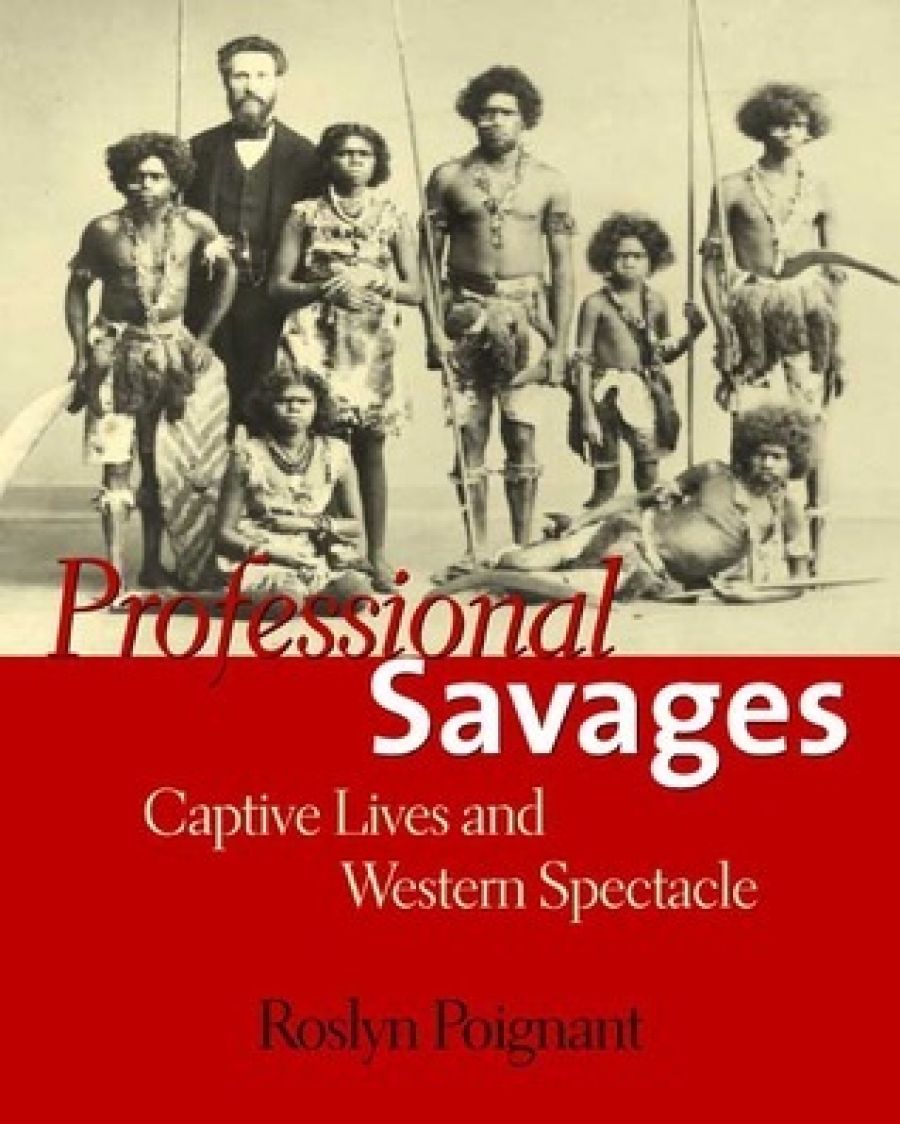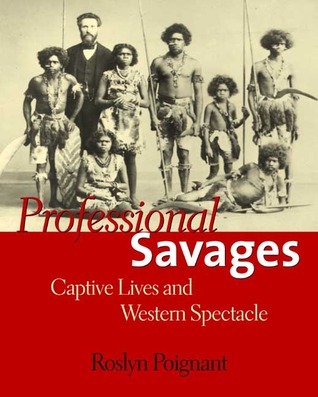
- Free Article: No
- Contents Category: Indigenous Studies
- Review Article: Yes
- Article Title: Captive Audiences
- Online Only: No
- Custom Highlight Text:
One photograph in this beautifully produced book is indelible. It is Paris, 1885, and against a painted show backdrop, Billy, young Toby and his mother pose with their boomerangs and a miniature dog. The disoriented, troubled eyes of these north Queenslanders look you right in the face. The sharp-focus dog, a taxidermist’s creation, paradoxically strikes a more animated stance than the living humans. This macabre depiction of people as ‘types’ led Roslyn Poignant to investigate an historical epic of dynamic performers.
- Book 1 Title: Professional Savages
- Book 1 Subtitle: Captive lives and Western spectacle
- Book 1 Biblio: UNSW Press, $59.95 hb, 320 pp
- Book 1 Cover Small (400 x 600):

- Book 1 Cover (800 x 1200):

Professional Savages is about two troupes of Aboriginal people who, from 1882 onwards, were taken away from their homes in north Queensland to perform for the world. The book dramatically expands our knowledge of indigenous Australians as global travellers and as spectacles for European and American audiences. Albeit another shocking episode in the history of colonialism, the impressive adaptability of these dislocated travellers raises further questions: Did they continue to feel like the captives they were? Why did they keep performing? Did they always yearn for home or had they actively decided against returning? Of the survivors, only a few did return, and little is known of their subsequent lives.
So far away from their Queensland country and kin, the indigenous performers committed lo memory every place they visited across Europe and the US, with the same care they would devote to recounting journey routes across their own country. They pioneered the international performance of dances from north Queensland and showed off the technological innovation of the boomerang. As they were marketed as ‘Cannibal Savages’ from Australia, spectators demanded proof of how many people they had eaten and how recently. ‘Australian Cannibal’ shows were advertised alongside a range of ‘human freaks’. In the Universal Exposition of Paris, 1889, a painted image of ‘Jimmy’ appeared near the orangutan skeletons. In the zoos of Europe, the troupes regularly performed as human specimens.
Scientists and experts were among the keenest observers. The visits of people from distant lands gave them opportunities to take measurements and to judge their ‘authenticity’ against knowledge acquired from books. As the Indigenous Australians grew ill from the unfamiliar cold, tuberculosis, and other infectious diseases, it was hard to keep scientists away from their corpses. The death of Tambo upset the first Australian troupe terribly, but when the performer started to prepare the body according to their traditional rites, their ‘keeper’, R.A. Cunningham stopped them. More than a hundred years later, when a funeral parlour closed in Cleveland, Ohio, someone found Tambo’s preserved corpse. It had been displayed previously as an exhibit in a dime museum.
Cunningham was a slave-driver who bragged about capturing the performers and abandoned member of the troupes when they were too ill to produce profits. But he was considerate of indigenous kin protocols and naming customs, and, when he was making profits, provided good food, lodgings, and medical attention. The ageing Cunningham nostalgically visited the corpse of Tambo and shared his affectionate memories of him with local journalists. Despite market demand, Cunningham had prevented his other performers’ bodies being desecrated after their deaths.
Outsiders attempted to intervene in the Australians’ fate. Palani Paakiki, a native Hawaiian and fellow steerage passenger, petitioned for them to return home from San Francisco. A few years later, he lobbied the British consul to free ‘King Bill’ and company from miserable conditions at Coney Island, New York.
The indigenous Australians were trapped by distance, isolation, conditioning and deteriorating health. But they also demonstrated the limits of their tolerance. Refusing to cooperate beyond agreed boundaries, they protested at journalists entering their dining space and lashed out violently at poorly behaved servants and spectators. The ‘professional savages’ took pride in the quality of their performances. They expertly threw returning boomerangs over great and small distances – occasionally clipping a spectator to add to the excitement. Dressed up in their finery, they danced, showed off their painted shields and other weapons, and played ‘savage’. They also sold souvenirs: hand-carved weapons and postcards for which they posed. This is how they earned their living.
Poignant’s project is breathtaking in its scope. Her research journeys mirror those of the performers. She visited medical, anthropological and show-business collections, including the Crystal Palace Museum, Société de Geographie Photothèque, Musée de l’homme, over forty collections in the US, another eighteen in Germany, and more in Russia, Stockholm and Copenhagen. Poignant tracked down records of cemeteries and identified the performers’ likely graves. She talked to their relatives, listened to the snippets of oral records, observed the ritual significance of bringing back Tambo’s remains, and, in consultation with his relevant kin and community leaders, curated an exhibition for the National Library.
First published by Yale University Press, with numerous revealing illustrations, Professional Savages is an impressive yet unpretentious production that befits Poignant’s stunning achievement. These remarkable indigenous Australians; fascinated, thrilled and disturbed their often brutish audiences. In glimpsing their lives, we come face to face with a global history that touched, and still touches, spectators on every side of the show.


Comments powered by CComment